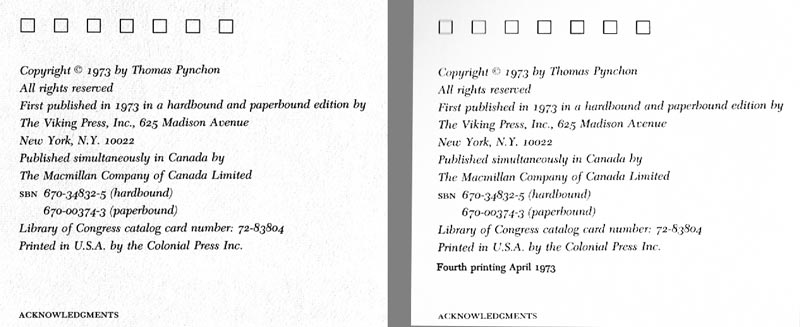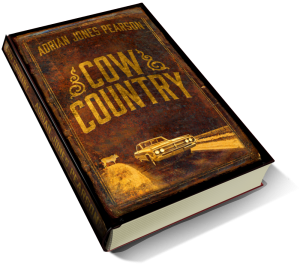For both the original hardcover and paperback versions of Gravity’s Rainbow, the differences between the true first editions and the Book Club editions are fairly subtle, but easy to spot.
When the Viking Press published Thomas Pynchon’s Gravity’s Rainbow in 1973, it simultaneously issued 4,000 hardbacks and 16,000 paperbacks. The reason for publishing the less-expensive paperback ($4.95) at the same time as the hardback ($15.00) was due to the concern of Corlies “Cork” Smith, Pynchon’s editor at the time, that Pynchon’s readership — younger, college-educated, hipper — might balk at coughing up $15 for the novel.
From the Bookforum website: “Pynchon from A to V: Gerald Howard on Gravity’s Rainbow
Now the real problem presented itself: How to publish a seven-hundred-plus-page book at a price that would not be grossly prohibitive for Pynchon’s natural college and post-collegiate audience. V. and The Crying of Lot 49 had each sold more than three million copies in their Bantam mass-market editions. […] According to a letter from Cork Smith [Pynchon’s editor] to Bruce Allen (who reviewed Gravity’s Rainbow for Library Journal but wrote to Viking complaining about the novel’s price), Viking would have had to sell thirty thousand copies at the then unheard of price of $10 just to break even. By comparison, V. and The Crying of Lot 49 had sold about ten thousand copies apiece in hardcover. So how to reach even a fraction of the cash-strapped Pynchon-loving millions? Cork himself hit on the then unique strategy of publishing an original trade-paperback edition at $4.95 and “an admittedly highly priced hardcover edition” at $15, each identical in paper stock and format, differing only in their binding. The gamble: “We also thought that Pynchon’s college audience might, just might, be willing to part with a five-dollar bill for this novel; after all, that audience spends that amount over and over and over again for long-playing records.” The other gamble was with the reviewers, who rarely took paperback fiction seriously, but as Cork wrote, “We feel — as, clearly, you do — that Pynchon cannot be ignored.”
As you may know, both editions in their first printings are quite valuable, particularly the hardcover (and even superior copies of subsequent printings of the first edition), but also the first edition/first printing of the paperback edition. However, the differences between true first editions and the subsequent Book of the Month Club (“BoMC”) (hardcover) and Quality Paperback Book Club (“QPBC”) editions of Gravity’s Rainbow, both published in 1973 (Thomas Pynchon: A Bibliography of Primary and Secondary Sources, Clifford Mead, p.13), are a bit subtle, but easy to identify when you know what to look for.
NOTE ABOUT VALUE: First editions of both the hardcover and paperback editions of Gravity’s Rainbow are only of significant value if they’re first printings, although later printings of both are still pricier than later editions. Printings subsequent to the first printings are clearly indicated on the copyright page, after the line “Printed in U.S.A. by the Colonial Press Inc.” If there is no indication of a subsequent printing, then it’s a first printing (assuming, of course, it meets the other criteria in this article). See the below example:
Both the hardcover and paperback editions went into multiple printings after the first run. BoMC hardcover editions generally go for between $100 – $300, depending on their their condition (VG to Fine). The QPBC paperbacks are not worth that much at all and should only fetch more than, say $10, only if they are misrepresented as first editions.

